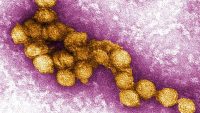Yersinia pestis is a bacterium responsible for causing the infamous infectious disease known as plague. Plague has played a significant role in human history, with major pandemics such as the Black Death during the 14th century that resulted in widespread morbidity and mortality. Yersinia pestis belongs to the Yersinia genus and is primarily transmitted through the bites of infected fleas, which commonly infest rodents like rats. Humans can contract the disease through direct contact with infected animals or their fleas.
There are three forms of plague caused by Yersinia pestis : bubonic, septicemic, and pneumonic. Bubonic plague is characterized by the sudden onset of fever, chills, weakness, and the development of painful, swollen lymph nodes (buboes). Septicemic plague occurs when the bacteria spread to the bloodstream, causing symptoms like shock, abdominal pain, and vomiting. Pneumonic plague, the most severe and transmissible form, affects the respiratory system and can be transmitted between humans through respiratory droplets, posing a significant public health concern.
While modern antibiotics are effective in treating Yersinia pestis infections, the bacterium remains a potential biological weapon due to its historical impact and the potential for rapid spread. Efforts in public health, including surveillance, prevention measures, and early detection, play a crucial role in mitigating the impact of Yersinia pestis and preventing outbreaks of plague in vulnerable populations.

To know more about Yersinia pestis , let’s take a look at these 10 interesting facts about Yersinia pestis .
- Black Death Pandemic: Yersinia pestis gained notoriety during the Black Death pandemic in the 14th century, one of the deadliest pandemics in human history. The bacterium was responsible for causing widespread death, with estimates suggesting that it wiped out a significant portion of Europe’s population.
- Flea Vector: Yersinia pestis is primarily transmitted through the bites of infected fleas, particularly those that infest rodents like rats. Fleas become carriers of the bacterium after feeding on infected animals and can transmit the disease to humans through subsequent bites.
- Bubonic Plague: The most common form of plague caused by Yersinia pestis is bubonic plague. It is characterized by the sudden onset of fever, chills, weakness, and the development of painful, swollen lymph nodes, known as buboes.
- Septicemic Plague: Yersinia pestis can cause septicemic plague when it spreads to the bloodstream. This form of the disease is associated with severe symptoms such as shock, abdominal pain, vomiting, and can be fatal if not promptly treated.
- Pneumonic Plague: Pneumonic plague is the most severe and transmissible form of Yersinia pestis infection. It affects the respiratory system and can be transmitted between humans through respiratory droplets, making it a serious public health concern.
- Biological Weapon Potential: Due to its historical impact and potential for rapid transmission, Yersinia pestis is considered a potential biological weapon. Efforts to control the spread of the bacterium and develop countermeasures are essential for biosecurity.
- Modern Antibiotic Treatment: While Yersinia pestis is a deadly pathogen, modern antibiotics, such as streptomycin and gentamicin, are highly effective in treating plague if administered promptly. Early diagnosis and treatment are critical for a positive outcome.
- Natural Reservoirs: Yersinia pestis has natural reservoirs in various rodent species, including rats and ground squirrels. These animals play a crucial role in maintaining the bacterium in the environment, facilitating its transmission to fleas and, subsequently, to humans.
- Endemic Areas: Plague is considered endemic in certain regions, particularly in parts of Africa, Asia, and the Americas. While the occurrence of large-scale pandemics has decreased, sporadic cases still occur, and vigilance is required for timely response and control.
- Public Health Measures: Public health measures, including surveillance, pest control, and community education, are vital in preventing and controlling outbreaks of Yersinia pestis . Early detection of cases, prompt treatment, and preventive measures such as vaccination contribute to reducing the impact of the disease in vulnerable populations.
Yersinia pestis , the bacterium responsible for plague, is a microorganism that has left an indelible mark on human history. From the devastating Black Death pandemic to its potential as a biological weapon, Yersinia pestis has been a formidable force, causing significant morbidity and mortality throughout the ages. While the specter of plague continues to linger, modern medicine has armed us with antibiotics that can effectively treat Yersinia pestis infections if administered promptly.
Vigilance in public health, including surveillance, pest control, and community education, remains crucial in preventing and mitigating the impact of this deadly bacterium. Understanding its biology, modes of transmission, and historical significance empowers societies to confront the persistent threat of Yersinia pestis and work towards a safer and healthier future.



